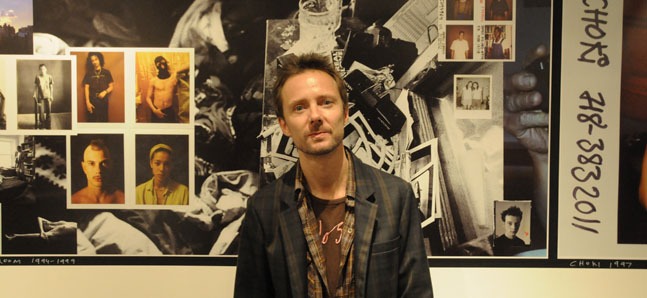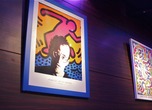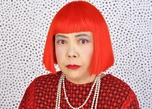
Posted: Wed May 05 2010
New York, Stockholm, Bangkok – and now Tokyo – have all been stages for the photography of Jesper Haynes. The exhibition entitled ‘Blurring the Line Between Life and Art: St Marks 1986-2006’ was held at Time Out Café & Diner until Tuesday April 27. From the 80s and spanning 20 years, Haynes lived in a one-room East Village apartment that saw a parade of friends, lovers and other passersby from around the world; a lifestyle which was documented in photos. The photos were presented without frames, lending them an air of rawness against the walls of the gallery, showing the contact sheets an all, spread all over the walls in a collage.
Just before the closing of the exhibition, Time Out caught up with Jesper to ask about how he came to give such a show here in Tokyo.

When did you start living in New York?
JH: I came to New York in the summer of 1978; I was only 16. I was supposed to stay with my grandparents in Texas. I didn’t tell my mum that I was going to stop over New York. I was in a taxi coming into Manhattan, and I felt like ‘I’m home’. I thought that this is where I want to live.
Before that, what was your idea about New York?
JH: Only from movies like Taxi Driver. I always wanted to go to New York. I was very fascinated with Andy Warhol – that was one reason. Actually, I met Andy Warhol in the spring of 1978 when I showed my pictures in Sweden. He told me, ‘When you are in New York, come and visit me.’ So I went to New York in 1978 and I stayed for two months – went to clubs and it was amazing. The best summer in my life. I went back to Sweden to finish school, but always wanted to go back, and I moved to New York in 1982.
So when you were 16, were you already a photographer?
JH: I was taking photos since I was 10 or 11. I decided to be a photographer. I think it’s because of the comic ‘TinTin’. He was a journalist and travelled around the world, so I wanted to do the same. He never worked, so I thought it was perfect.
When did you start taking the pictures [in the exhibition]?
JH: I always took pictures all my life since I was little kid, so I never thought this is a project. It’s natural to me to take pictures. When I moved into this apartment, I thought, ‘I’ll stay in New York one or two years.’ But I just kept shooting every day. The theme is more about one apartment that became a home to so many people, which also represents the East Village, as New York is home for many people from all over the world.
A lot of things changed in East Village. How do you describe this 20 year period in New York?
JH: During 20 years, I went through 1986 to 2006. That was a most exciting time. People like Keith Haring and everybody hung around in city, so the 80s were all about art and clubs. Art met night life. The 90s were still interesting, but starting to change. The East Village had become too popular, and in 2000 it was over. My East Village doesn’t exist anymore.
After 2006, did you move out of New York?
JH: Yes, because it changed a lot. I travelled around for a year and I didn’t like George Bush, so I thought maybe to move to either Bangkok or Tokyo, but then I found my apartment in Williamsburg.
When it was good in the East Village there was a strong community and more people from different countries. There are more Americans in Williamsburg, but prefer a mix of people.
How do you feel about showing your photos to an audience?
JH: Now I like to do shows, but when I was young, I didn’t want people to criticise my work. Now I don’t care. I like my pictures, so if someone doesn’t like it, it’s okay, someone likes it, it’s okay. It’s for me.
How did you come up with this way of installation, a collage?
JH: I think I always do the contact sheet on the floor like this. When I edit, a lot of times I’m sitting on floor with the contact sheet everywhere, so it’s kind of like the way I work – and I don’t like frames.

Yes, I felt the pictures more directly.
JH: Sometimes it makes the photos too holy, like in a sanctuary.
So you show in Bangkok. I heard the art scene there is growing.
JH: It’s interesting. I love Bangkok, so I spend a lot of time there.
But half-and-half is perfect for me. I love Bangkok and New York but don’t want to live there for 12 months; every time I stop in Tokyo between Bangkok and New York.
What do you think about Tokyo?
JH: I like it a lot but I never stayed here long. Everybody’s nice and goes to parties.
Why did you choose the four cities for your show: Stockholm, Bangkok, Tokyo, and New York?
JH: I think little bit has to do about food. I eat Japanese a lot. I like big cities, crazy cities; I don’t like small cities. To me, New York is a big city, and it has people from all over the world. Then Bangkok, I feel it’s getting bigger – so enormous. Every day I discover new things in Bangkok. Tokyo, for people, is nice.
What’s similar in New York and Bangkok?
JH: New York, when I arrived in late 70s, it was completely messed up in so many ways. Smelly, disgusting, drugs and sex, but an exciting city for kids, but New York has slowly lost that. I came to Bangkok and I felt, ‘WOW! This is another smelly, disgusting, sex and drugs kind of rock ’n roll city.’ Bangkok is like New York – you never know what will happen. There aren’t cities like that anymore.
We’re Time Out, so please tell us your favourite place to go out.
JH: If I find the place I like, I go there all the time. I cook at home a lot, but if I go out, basically I have two restaurants to go to in New York, Japanese restaurants. One is a tiny sushi restaurant called Natori, and the other is Yokocho, and I shop for Japanese food at a supermarket called Sunrise.
We found out your father has some relation to Time Out London.
JH: My dad said ‘It’s my idea. I told Tony Elliot, you should do the magazine about London.’ I thought, ‘You say everything is your idea,’ but this time it was true. He’s known Tony for a long time, so my dad was happy I’m having show at the Time Out gallery.
About Jesper Haynes
Born in Edinburgh, Scotland, in 1962 and raised between Sweden, France and the US, Jesper Haynes moved to New York in 1982, where he spent five years working for the American art photographer Ralph Gibson. In addition to working for various internationally published magazines and a range of commercial fashion clients, his photographs make up a part of the permanent collection at the Museum of Modern Art in Stockholm. He now divides his time between his New York City base, Stockholm, Bangkok and Tokyo.
Tweets
- About Us |
- Work for Time Out |
- Send us info |
- Advertising |
- Mobile edition |
- Terms & Conditions |
- Privacy policy |
- Contact Us
Copyright © 2014 Time Out Tokyo














1 comment Add a comment
A delightful interview. I really enjoyed it. But in the middle of reading it, I was interrupted by a phone call from Jesper in New York City. He did not talk about Paris which is another great city where I have lived for 40 years.
Add your comment